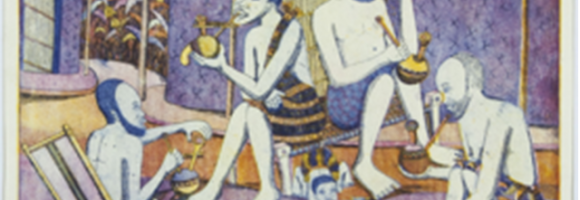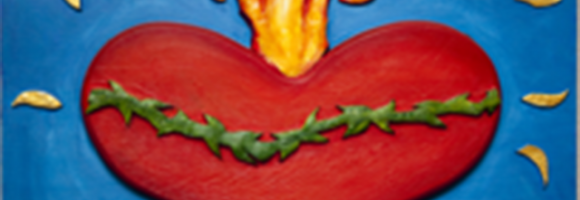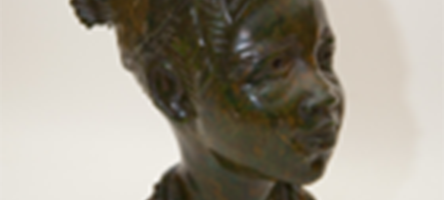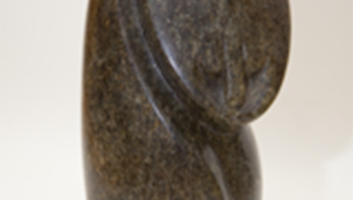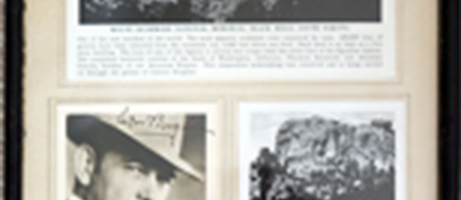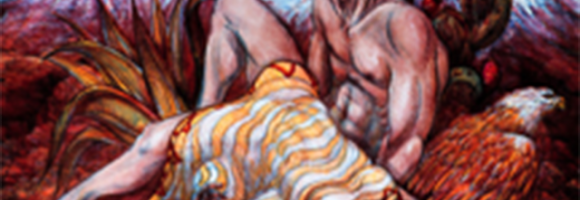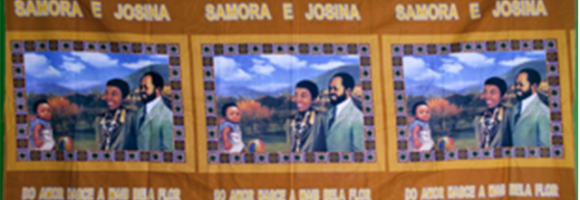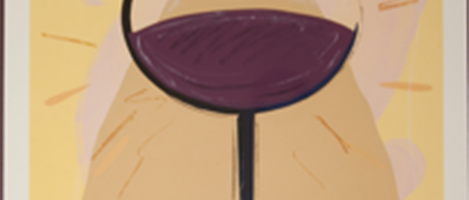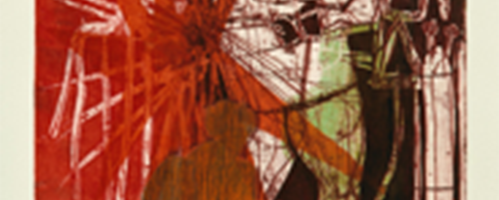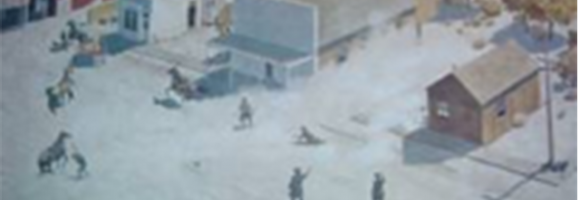Robino Ntila
Robino Ntila is an artist based in Tanzania. He works with artists all over Africa, conducting printmaking workshops, mostly with the support of the Ford Foundation. He has taught many artists how to print, helping them market their work in the process.
Robino worked closely with the famous Makonde artist George Lilanga, teaching him the art of printing. Lilanga, one of the few early carvers able to transition from three-dimensional to two-dimensional work, made the transition from carver to visual artist in a movement called Tinga Tinga. His distinct style characterized the start of the movement in Tanzania, one which Ntila continues today, alongside Lilanga’s son.
I met Robino Ntila in Nairobi in 1994. I have more than one hundred Ntila prints, as the artist used to send them to me once a year. Today, Ntila has taken to painting, and thus no longer sends me etchings.
Ruben Galicia
These prints are by a group of artists I have become close with since moving to Arizona in 2001, most of which have exhibited work at Promega. All of these artists belong to several organizations comprised of Latino and American Indian artists in the Phoenix area.
I’ve come to find a very rich art scene in Arizona, much as I did living in Kenya years ago. In both places, I became involved with and had the good fortune to work with artists and to exhibit their work.
I have come across great artists all over the world and have somehow managed to end up with a diverse collection of art pieces to remind me of those relationships. By far, the most interesting and valuable aspect of what I do is getting to know unique and fascinating people.
Artist Unknown
Zimbabwean Stone sculptures are often called Shona Sculptures. Zimbabwe, a southern African country whose name literally means “the house of stone,” is known for its remarkable stone sculptors. The Shona sculptors’ work is often inspired by deeply-held spiritual beliefs, folklore and daily life, and have in turn inspired many western artists. While modern in inspiration, Shona sculptures are created much as they were in the past, using simple chisels to “release” the spirits of the stone.
For more information on Shona Sculptures, click here.
Inuit art, produced by the people of the Arctic, are historically carved from walrus ivory. Since the establishment of southern markets for Inuit art in 1945, however, the use of soft stone such as soapstone, serpentine, or argillite for the carving of figurative works has increased in popularity.
For more information regarding Inuit Stone Sculptures, click here.
Artist Unknown
Zimbabwean Stone sculptures are often called Shona Sculptures. Zimbabwe, a southern African country whose name literally means “the house of stone,” is known for its remarkable stone sculptors. The Shona sculptors’ work is often inspired by deeply-held spiritual beliefs, folklore and daily life, and have in turn inspired many western artists. While modern in inspiration, Shona sculptures are created much as they were in the past, using simple chisels to “release” the spirits of the stone.
For more information on Shona Sculptures, click here.
Inuit art, produced by the people of the Arctic, are historically carved from walrus ivory. Since the establishment of southern markets for Inuit art in 1945, however, the use of soft stone such as soapstone, serpentine, or argillite for the carving of figurative works has increased in popularity.
For more information regarding Inuit Stone Sculptures, click here.
Gutzon Borglum
Gutzon Borglum was a Danish-American artist and sculptor best-known for creating the monumental presidents’ heads at Mount Rushmore, South Dakota.
While developing the monument, Borglum began running out of funds and thus conducted quite a bit of fundraising. My guess is this was something he sold or gave to potential investors to promote his ideas.
This framed set was acquired at an estate sale, where I had the opportunity to speak with the grandson of the original owner. The man had unpacked a box of things with this item inside that very day and had never seen it before. Had it been hanging on a wall in Arizona all of these years, I would guess it would have been greatly deteriorated. As it was, it was very well preserved, luckily for me.
Luis Jiménez
This stone lithograph is by Luis Jiménez. Jiménez was known for his large polychrome fiberglass sculptures usually of Southwestern and Hispanic themes. His work is known for often being controversial and he is well recognized for his use of bright, colorful surfaces.
I bought this piece at an estate sale about two years ago. I was familiar with this image because the Arizona State University Art Museum has two prints from this addition of 50. A large sculpture based on this image can also be found just outside of the museum.
I had the honor of meeting Jiménez several times and may have been the last person to photograph him. Luis passed away in 2006, when a large section of a sculpture fell on him and severed an artery in his leg.
Details on this piece can be found here. For more information about Luis Jiménez and his artwork, visit this link.
Artist Unknown
Lesos, or kangas, are popular garments worn by women, and sometimes men, in East Africa. These can be utilized in numerous creative ways, although most are traditionally worn as dresses. Kanga designs have evolved over the years, from simple spots and borders to a huge variety of elaborate and colorful patterns.
Although most kangas tend to be decorative, due to the simplicity in wearing, kangas can be utilized in political gatherings as a form of identity for people supporting a particular political party. These lesos are great examples of the use of these garments for political affiliations.
This set is from the estate of Sharon P. Wilkinson, former United States Ambassador to Mozambique from 2000-2003.
For more information regarding kangas, click here.
Joe Ray
These prints are by a group of artists I have become close with since moving to Arizona in 2001, most of which have exhibited work at Promega. All of these artists belong to several organizations comprised of Latino and American Indian artists in the Phoenix area.
I’ve come to find a very rich art scene in Arizona, much as I did living in Kenya years ago. In both places, I became involved with and had the good fortune to work with artists and to exhibit their work.
I have come across great artists all over the world and have somehow managed to end up with a diverse collection of art pieces to remind me of those relationships. By far, the most interesting and valuable aspect of what I do is getting to know unique and fascinating people.
Warrington Colescott
I bought this etching at the same estate sale where I purchased the “Southwest Pietá” by Luis Jiménez. I noticed this print as I walked out the door. It was a beautiful etching and I purchased it for far less than it is worth.
Once at home I inspected the artwork more closely and realized I had met the artist, Warrington Colescott. He has many ties to Madison and still lives in the area.
This print was framed in a 60s mid-century, modern wooden frame, which unfortunately could not be salvaged due to its condition. It did, however, make for a striking addition to the piece.
Read more about Warrington Colescott.
Artist Unknown
These three items are part of an assortment of Wyatt Earp works I have collected in the last fifteen years. Since moving to Arizona, I have been able to more thoroughly research Old West historians. Last year, Promega showcased historical photos of Arizona from the collection of Jeremy Rowe and Jeremy, for one, has written extensively about this photo of Wyatt Earp’s wife.
This photo, called Kaloma, depicts the woman thought to be the wife of Wyatt Earp. I found it in Greece in 1997 at an antique shop located in downtown Thessaloniki. The one displayed is a reproduction, since the original is too fragile to display for three months. The controversy about the true identity of the woman depicted in the photo is typical of Old West lore and embellishments of the truth about that time in our history.
The photograph of Jennifer Tilly posing in reflection of Kaloma is by John Beckett. This and other shots from the same photo shoot can be found in the issue of True West magazine currently located in the Promega library. This issue of True West was the fastest selling issue they have ever had.
I own various books and a collection of over 600 negatives from Tombstone, AZ circa 1915. I have been working with the Historical Society there to preserve these images. Last year I stayed at an RV camp in Tombstone. It took me about one hour of sitting on a bench and talking to locals to connect with just about everyone who claimed to be an expert of the history of The Shootout at the OK Corral nearby. Tombstone, “The Town Too Tough to Die,” is my favorite bit of Americana.
